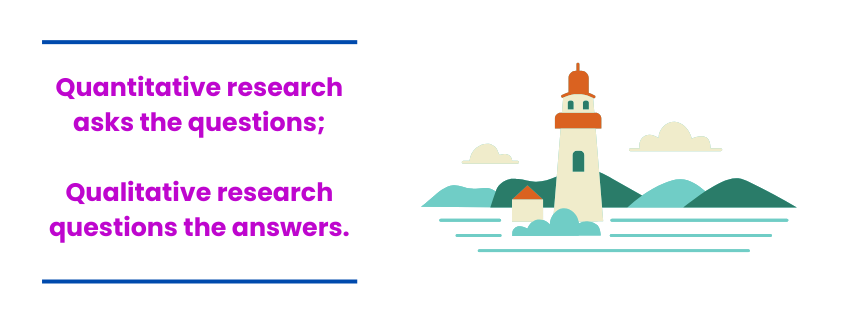Reasons for Keeping Quantitative Research Out of Qualitative Research
In the world of market research, there sometimes seems to be a tendency to try to blend Quant research with Qual research. The reasons for maintaining a clear distinction between the two highlights the key strengths of each methodology. Simply stated, Quant relies on specific objective questions; Qual focuses on determining the nuances… the depth of how people’s Perceptions, Opinions, Beliefs, and Attitudes (POBAs) shape and trigger purchasing choices, product or service uses, how messaging is perceived, and the reasons selective actions directly related to a product, services, or other ideas are done.
The goal of Qualitative market research is to gain as much insight as possible into a given issue without having a pre-ordained framework for the information. It is inductive analysis – a deliberate alternative to explaining the world through pre-defined structures and hypothesis testing. Therefore, Qualitative research differs from Quantitative research in that it is intended to find out what formed the basis for quantitative responses.

Qualitative research is grounded in exploring meaning, experience, and context. It thrives on depth, complexity, and nuance. Introducing quantitative measures—numbers, scales, percentages—can flatten the richness of lived experience into something more rigid and formulaic. By keeping quantitative tools out, qualitative research maintains its philosophical foundation: the search for understanding rather than measurement.
Pure qualitative research resists the attempts to put human beings and the uniqueness of human experience into a box, rather than illuminating the layers of complexity behind their POBAs.
Blending the two can lead to contradictions, which are often ignored or at best flatten or muddle the findings. Numbers can give an illusion of precision but often strip away the context that makes human experiences meaningful. For example, a survey might report that “80% of participants felt stressed,” but that statistic cannot capture why or how stress was experienced differently across individuals. Keeping them separate allows each to operate within its own coherent framework.
Qualitative methods—like interviews, ethnography, and participant observation—allow for adaptation in the moment. The Researcher can follow unexpected themes as they emerge. Adding quantitative elements (structured scales, fixed-choice questions) reduces this flexibility, forcing the study into predefined categories instead of letting Participants’ voices lead the way.
Participants in Qualitative research are often invited to share stories, reflections, and lived experiences. Reducing these voices to numerical data risks silencing the very insights that Qualitative inquiry seeks to elevate. A purely qualitative approach ensures that stories stay intact and meaningfully represented.
Final Thoughts:
Both Qualitative and Quantitative research have value. But they do not need to be forced into the same space. Qualitative research is strongest when it resists the urge to quantify, instead embracing its unique ability to uncover depth, complexity, and meaning. By keeping quantitative research out, qualitative inquiry remains true to its purpose: to understand human experience in all its richness.
Written by: Romaine Bailey, Master Coach & Trainer

